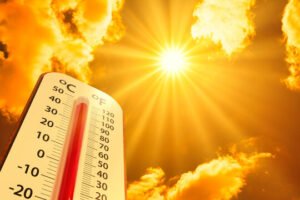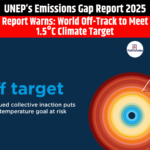2025 Could Be One of the Hottest Years Globally Says WMO
|
General Studies Paper III: Environmental Pollution & Degradation |
Why in News?
Recently, the World Meteorological Organization (WMO) State of the Global Climate Update 2025 highlighted that year 2025 is likely to rank among the top three hottest years in the planet’s 176-year climate record. WMO stated that this trend reflects ongoing climate change driven by human activity, demanding urgent awareness and action.
Key Findings of WMO State of the Global Climate Update 2025
- The World Meteorological Organization (WMO) has presented a detailed report ahead of COP30 in Belém, Brazil, showing that the year 2025 is projected to become either the second or third warmest year in the 176-year global climate record.
- The global mean near-surface temperature for January to August 2025 stood at 1.42°C ± 0.12°C above the pre-industrial average, slightly below 2024’s record of 1.55°C ± 0.13°C. This marks the eleventh consecutive year (2015–2025) of record-breaking warmth.
- The report notes that the high temperatures of recent years are partly influenced by El Niño and the fading effects of a long La Niña phase that ended in early 2023.
- The concentration of carbon dioxide (CO₂), methane (CH₄), and nitrous oxide (N₂O) in the atmosphere reached their highest recorded levels in 2024, and early observations suggest further increase in 2025.
- The average CO₂ concentration rose to 423.9 parts per million (ppm) in 2024, up from 278 ppm in 1750 — a 53% increase since pre-industrial times. The annual rise between 2023 and 2024 was 3.5 ppm, the highest jump ever documented.
- The ocean heat content reached unprecedented levels in 2025, surpassing the record set in 2024. Over 90% of the extra heat from greenhouse gas emissions is absorbed by oceans, making them a central indicator of climate change.
- Ocean warming has intensified over the last two decades, leading to marine ecosystem damage, coral bleaching, and loss of biodiversity. The warming waters also fuel more powerful tropical cyclones and accelerate polar ice melt.
- According to satellite data, the global sea level continues to climb. The rate of rise has almost doubled, from 2.1 millimeters per year (1993–2002) to 4.1 millimeters per year (2016–2025).
- The year 2024 recorded the highest mean global sea level, with a minor temporary drop noted in early 2025 due to La Niña effects. This persistent rise is driven by thermal expansion of seawater and melting glaciers and ice sheets.
- Arctic and Antarctic regions continue to lose ice at alarming rates. In March 2025, the Arctic sea ice extent reached its lowest winter maximum on record at 13.8 million km², while its minimum in September 2025 was 4.6 million km², below the long-term average.
- The Antarctic sea ice was the third lowest on record with 2.1 million km² at its minimum. Glaciers worldwide recorded net mass loss for the third consecutive year (2023–2024), losing approximately 450 gigatonnes of ice, equivalent to 1.2 mm of global sea-level rise.
- The year 2025 witnessed widespread extreme events causing social and economic disruption. Regions across Asia, Africa, Europe, and North America experienced record-breaking floods, wildfires, tropical cyclones, and prolonged heatwaves.
- The WMO report notes significant progress in multi-hazard early warning systems (MHEWS). Since 2015, the number of countries reporting operational MHEWSs increased from 56 to 119 by 2024. Despite this, 40% of countries still lack comprehensive early warning coverage.
The Science Behind Rising Global Temperatures
- Greenhouse Gases: The steady increase in greenhouse gases is the main driver of rising global temperatures. Gases such as carbon dioxide (CO₂), methane (CH₄), and nitrous oxide (N₂O) trap heat in the Earth’s atmosphere. This process is known as the greenhouse effect. Since the Industrial Revolution in the late 18th century, human activities like burning fossil fuels, industrial production, and deforestation have released vast amounts of these gases.
- Deforestation: Deforestation and large-scale land-use changes reduce the planet’s natural ability to absorb carbon. Forests act as carbon sinks, capturing carbon dioxide and storing it in trees and soil. When trees are cut or burned, the stored carbon is released back into the atmosphere. Agriculture expansion and urban development also alter the surface reflectivity, known as albedo, causing more solar radiation to be absorbed.
- Ocean Heat Absorption: The world’s oceans absorb more than 90% of the excess heat generated by greenhouse gas emissions. This makes the ocean heat content (OHC) a crucial indicator of climate change. Warmer oceans release heat back into the atmosphere, fueling extreme weather patterns such as cyclones and heavy rainfall. Ocean warming also weakens the ability of water to absorb carbon dioxide.
- Industrial Emissions: Human industries and agriculture are responsible for large amounts of methane and nitrous oxide, both far more powerful than carbon dioxide in trapping heat. Methane emissions come from livestock, landfills, and oil and gas operations. Nitrous oxide mainly comes from fertilizer use and soil degradation. These gases have shorter lifespans than CO₂ but create intense warming effects in the short term.
- Aerosol Reduction: While greenhouse gases warm the planet, aerosols—tiny particles from pollution—can temporarily cool it by reflecting sunlight. In recent years, global aerosol emissions have decreased due to cleaner energy transitions and air-quality policies. Changes in atmospheric composition have also altered cloud formation and rainfall distribution. While reducing aerosols is good for human health, it can lead to a short-term spike in global temperatures.
- Feedback Loops: The Earth’s climate system includes feedback loops that amplify warming once it begins. One example is the ice-albedo feedback. As polar ice melts, darker ocean surfaces absorb more sunlight, increasing heat absorption and accelerating further melting. Another loop involves permafrost thaw, which releases trapped methane and carbon dioxide.
Impact of Rising Global Temperatures
- Extreme Weather Events: Rising global temperatures are increasing the intensity and frequency of extreme weather events across the world. Heatwaves, heavy rainfall, and prolonged droughts are becoming more common. Warmer air holds more moisture, causing heavier rainfall and severe flooding. At the same time, some regions experience dry spells leading to wildfires and crop failures.
- Rising Sea Levels: The continuous increase in temperature has caused rapid melting of glaciers and polar ice caps. This directly contributes to sea-level rise, which threatens coastal regions and small island nations. Cities like Mumbai, Jakarta, and New York face higher flood risks due to this trend. The loss of ice in Greenland and Antarctica also reduces the planet’s reflectivity, trapping more heat and worsening global warming.
- Agricultural Productivity: Climate change is having a serious impact on agriculture and food production. Rising temperatures affect soil moisture, crop yields, and growing seasons. Changing rainfall patterns disrupt irrigation cycles and lead to pest outbreaks. Drought conditions in Africa and Latin America have worsened food insecurity. The agricultural sector is now facing lower productivity and higher production costs due to unpredictable weather conditions.
- Human Health: Higher temperatures are increasing the burden of heat-related illnesses and vector-borne diseases. Hotter climates allow mosquitoes to spread diseases such as malaria and dengue into new regions. Air quality also declines as heat intensifies the formation of ground-level ozone, a harmful pollutant. Urban populations are particularly at risk due to the urban heat island effect, where concrete surfaces trap more heat.
- Biodiversity Loss: The warming planet is transforming ecosystems and threatening biodiversity. Species are being forced to migrate to cooler regions, while some cannot adapt and face extinction. Coral reefs, which host a quarter of all marine life, are suffering severe bleaching due to warmer oceans. The loss of these ecosystems reduces natural carbon storage, disrupts food chains, and weakens the planet’s ecological balance.
- Economic Disruption: The economic cost of rising temperatures is growing rapidly. According to the Munich Re, climate-related disasters caused losses of over $320 billion globally in 2024. Infrastructure damage, health crises, and reduced agricultural productivity are slowing economic growth in developing countries. These disruptions also deepen inequalities, as poorer nations lack the resources to adapt and recover from repeated climate shocks.
The Road Ahead
- Global Climate Cooperation: Upcoming climate summits such as COP30 in Belém, Brazil, are crucial for ensuring accountability and increasing ambition in national commitments. Wealthier nations must deliver on their pledges to provide climate finance and technology transfers to developing economies to support adaptation projects, renewable energy expansion, and disaster preparedness programs.
- National Policy Reforms: Countries must embed climate resilience into their national development strategies. Governments are increasingly integrating climate risk assessment into urban planning, agriculture, and industrial policies. For example, India’s National Action Plan on Climate Change (NAPCC) focuses on missions related to solar energy, sustainable agriculture, and energy efficiency.
- Renewable Technologies: Transitioning to green technologies is central to balancing development with climate action. Renewable energy sources such as solar, wind, hydro, and green hydrogen are replacing fossil fuels in power generation and transportation. Electric mobility, smart grids, and energy storage systems are reshaping modern infrastructure.
- Sustainable Lifestyles: Sustainability must begin at the individual and community level. Changing consumption habits and promoting responsible resource use are key to reducing environmental pressure. Initiatives such as Mission LiFE (Lifestyle for Environment) launched by India in 2022 encourage citizens to adopt eco-friendly practices. Education, awareness, and behavioral change are vital in achieving climate goals.
|
Also Read: India Emerges as a Leading Contributor to Global Greenhouse Emissions |










